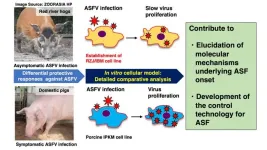(Press-News.org) A new paper in Biology Methods and Protocols, published by Oxford University Press, shows that scientists can train artificial intelligence models to distinguish brain tumors from healthy tissue. AI models can already find brain tumors in MRI images almost as well as a human radiologist.
Researchers have made sustained progress in artificial intelligence (AI) for use in medicine. AI is particularly promising in radiology, where waiting for technicians to process medical images can delay patient treatment. Convolutional neural networks are powerful tools that allow researchers to train AI models on large image datasets to recognize and classify images. In this way the networks can “learn” to distinguish between pictures. The networks also have the capacity for “transfer learning.” Scientists can reuse a model trained on one task for a new, related project.
Although detecting camouflaged animals and classifying brain tumors involves very different sorts of images, the researchers involved in this study believed that there was a parallel between an animal hiding through natural camouflage and a group of cancerous cells blending in with the surrounding healthy tissue. The learned process of generalization - the grouping of different things under the same object identity – is essential to understanding how network can detect camouflaged objects. Such training could be particularly useful for detecting tumors.
In this retrospective study of public domain MRI data, the researchers investigated how neural network models can be trained on brain cancer imaging data while introducing a unique camouflage animal detection transfer learning step to improve the networks’ tumor detection skills.
Using MRIs from public online repositories of cancerous and healthy control brains (from sources including Kaggle, the Cancer Imaging Archive of NIH National Cancer Institute, and VA Boston Healthcare System), the researchers trained the networks to distinguish healthy vs cancerous MRIs, the area affected by cancer, and the cancer appearance prototype (what type of cancer it looks like). The researchers found that the networks were almost perfect at detecting normal brain images, with only 1-2 false negatives, and distinguishing between cancerous and healthy brains. The first network had an average accuracy of 85.99% at detecting brain cancer, the other had an accuracy rate of 83.85%.
A key feature of the network is the multitude of ways in which its decisions can be explained, allowing for increased trust in the models from medical professionals and patients alike. Deep models often lack transparency, and as the field grows the ability to explain how networks perform their decisions becomes important. Following this research, the network can generate images that show specific areas in its tumor-positive or negative classification. This would allow radiologists to cross-validate their own decisions with those of the network and add confidence, almost like a second robotic radiologist who can show the telltale area of an MRI that indicates a tumor. In the future, the researchers here believe it will be important to focus on creating deep network models whose decisions can be described in intuitive ways, so artificial intelligence can occupy a transparent supporting role in clinical environments.
While the networks struggled more to distinguish between types of brain cancer in all cases, it was still clear they had distinct internal representation in the network. The accuracy and clarity improved as the researchers trained the networks in camouflage detection. Transfer learning led to an increase in accuracy for the networks.
While the best performing proposed model was about 6% less accurate than standard human detection, the research successfully demonstrates the quantitative improvement brought on by this training paradigm. The researchers here believe that this paradigm, combined with the comprehensive application of explainability methods, promotes necessary transparency in future clinical AI research.
“Advances in AI permit more accurate detection and recognition of patterns,” said the paper’s lead author, Arash Yazdanbakhsh. “This consequently allows for better imaging-based diagnosis aid and screening, but also necessitate more explanation for how AI accomplishes the task. Aiming for AI explainability enhances communication between humans and AI in general. This is particularly important between medical professionals and AI designed for medical purposes. Clear and explainable models are better positioned to assist diagnosis, track disease progression, and monitor treatment.”
The paper, “Deep Learning and Transfer Learning for Brain Tumor Detection and Classification” is available (at midnight on November 19th) at https://academic.oup.com/biomethods/article-lookup/doi/10.1093/biomethods/bpae080.
Direct correspondence to:
Arash Yazdanbakhsh
Research Assistant Professor
Department of Psychological and Brain Sciences
Boston University
64 Cummington Mall, Room 149
Boston, Massachusetts 02215
yazdan@bu.edu
To request a copy of the study, please contact:
Daniel Luzer
daniel.luzer@oup.com
END
We could soon use AI to detect brain tumors
2024-11-19
ELSE PRESS RELEASES FROM THIS DATE:
TAMEST recognizes Lyda Hill and Lyda Hill Philanthropies with Kay Bailey Hutchison Distinguished Service Award
2024-11-19
TAMEST is pleased to announce Lyda Hill and Lyda Hill Philanthropies as the recipients of the Kay Bailey Hutchison Distinguished Service Award.
TAMEST is recognizing Lyda Hill and her team for empowering and enabling groundbreaking research in science and nature that profoundly impacts society. Lyda Hill, a successful businesswoman and world-renowned philanthropist, believes science can solve many of the world’s most challenging issues and has chosen to donate all of her estate to philanthropy and scientific research.
Aligned with this mission, Lyda Hill is committed to advancing science and public ...
Establishment of an immortalized red river hog blood-derived macrophage cell line
2024-11-19
Red river hogs (RRHs) (Potamochoerus porcus), a wild species of Suidae living in Africa, have grabbed much attention as an animal that harbors African swine fever virus (ASFV) as natural hosts. When ASFV infects domestic pigs and wild boars, it proliferates within macrophages, a type of immune cells, and infected pigs rapidly die suffering from symptoms such as fever and hemorrhage. On the other hand, ASFV infection in RRHs is asymptomatic and does not cause death, suggesting that RRH macrophages may have a protective mechanism against ASFV infection.
In vitro cell cultures of porcine macrophages are generally ...
Neural networks: You might not need to buy every ticket to win the lottery
2024-11-19
The more lottery tickets you buy, the higher your chances of winning, but spending more than you win is obviously not a wise strategy. Something similar happens in AI powered by deep learning: we know that the larger a neural network is (i.e., the more parameters it has), the better it can learn the task we set for it. However, the strategy of making it infinitely large during training is not only impossible but also extremely inefficient. Scientists have tried to imitate the way biological brains learn, which is highly resource-efficient, by providing machines with a gradual training process that starts with ...
Healthy New Town: Revitalizing neighborhoods in the wake of aging populations
2024-11-19
Planned suburban residential neighborhoods in metropolitan areas known as new towns were initially developed in England. The new town movement spread from Europe to East Asia, such as to Japan, South Korea, Hong Kong, and Singapore. In Japan alone, 2,903 New Towns were built, but many experienced rapid population decline and aging in the 40 years after their development. Therefore, they changed into old new towns and had to transform their facilities.
Dr. Haruka Kato, a junior associate professor at Osaka Metropolitan ...
High exposure to everyday chemicals linked to asthma risk in children
2024-11-19
A new study from researchers at Kumamoto University sheds light on a potential link between exposure to certain everyday chemicals during pregnancy and the development of asthma in children. The study analyzed data from over 3,500 mother-child pairs as part of the Japan Environment and Children’s Study (JECS), a large-scale nationwide research project.
Key Findings:
High levels of butylparaben, a chemical commonly used in personal care products like lotions and shampoos, during early pregnancy were associated with a 1.54-fold increase in the odds of asthma development in children ...
How can brands address growing consumer scepticism?
2024-11-19
Transparency and effective communication are critical for brands to gain and keep consumer trust according to new research.
The University of Adelaide’s Dr Kate Sansome, from the Adelaide Business School has led a study which suggests that consumers want brands to be transparent about topics that impact them.
“As sociopolitical issues become topical in the news and social media, brands are expected to be transparent about them; for example, as consumers face cost-of-living pressures, they will expect brands to be transparent about this issue,” says Dr Sansome, who conducted the study with the Professor Jodie Conduit and Dr ...
New paradigm of quantum information technology revealed through light-matter interaction!
2024-11-19
□ A research team led by Professor Jaedong Lee from the Department of Chemical Physics of DGIST (President Kunwoo Lee) has introduced a novel quantum state and a pioneering mechanism for extracting and controlling quantum information using exciton and Floquet states.
□ Collaborating with Professor Noejung Park from UNIST’s Department of Physics (President Chongrae Park), the team has, for the first time, demonstrated the formation and synthesis process of exciton and Floquet states, which arise from light-matter interactions in two-dimensional semiconductors. This study captures quantum information in real-time as it unfolds through entanglement, offering ...
MSU researchers find trees acclimate to changing temperatures
2024-11-19
Images
Climate change is a persistent and growing challenge to plant life on our planet. Changes to the environment that plants are unaccustomed to affect how they grow, putting much at risk. Increasingly, plant scientists are trying to determine how these environmental changes will impact plant life and whether plants will be able to acclimate to a new status quo.
Researchers from the Walker lab at the Michigan State University-U.S. Department of Energy Plant Research Laboratory, or PRL, are looking at how paper birch trees adapt to changing environments based on how they manage a vital plant process called photorespiration.
“If ...
World's first visual grading system developed to combat microplastic fashion pollution
2024-11-19
Over 14 million tonnes of microplastics are estimated to be lying on the ocean floor with the fashion industry among the worst pollutants.
But a new project led by textile experts at Heriot-Watt University in the Scottish Borders, is aiming to make fashion labels and consumers alike, more environmentally aware when manufacturing and buying new clothes.
For four years, a small team headed by Dr Lisa Macintyre, associate professor of textiles at the University’s School of Textiles and Design in the Galashiels campus, has overseen painstaking ...
Teenage truancy rates rise in English-speaking countries
2024-11-19
Working paper | Quantitative data analysis | People
Truancy rates have risen faster in developed English-speaking countries since the Covid-19 pandemic than in non-English-speaking countries, according to a new working paper by UCL researchers.
Teenage girls are also increasingly more likely to skip school than boys across Anglophone countries.
In 2022, 26% of all Year 11 pupils in England reported playing truant at least once in the last fortnight. This represented an increase from 2012 and 2018, the previous data capture points, when the figure was at 18% each time.
In the same year (2022), 29% of Year 11 girls in England reported skipping school in the past ...





